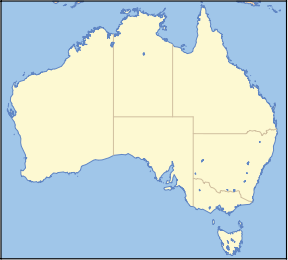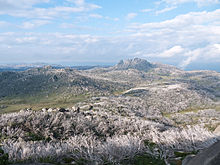- Mount Buffalo National Park
-
Mount Buffalo National Park IUCN Category II (National Park)Nearest town/city Bright Coordinates 36°44′18″S 146°46′30″E / 36.73833°S 146.775°E Area 310 km² Established 1898 Managing authorities Parks Victoria Official site Mount Buffalo National Park Mount Buffalo is a mountain plateau in Victoria (Australia), 200 km northeast of Melbourne. It is one of the oldest parks in the Australian Alps, being first established in 1898 when 1165 ha was reserved around Eurobin Falls. In 1908 it was expanded to over 105 km² and the park now covers 310 km² over the plateau and foothills of Mount Buffalo.
Mount Buffalo is a moderately tall mountain plateau (elev 1723 metres AHD at its highest point) on the west side of the Victoria Alpine region. The top of the mountain has striking granite boulders and rock formations. From the north, the mountain is quite remarkable, with the highest accessible point being a prominent peak called The Horn. A walking track leads to The Horn and visitors can enjoy a 360 degree view from the top.
Visitor accommodation was available at the historic guest house, the Mount Buffalo Chalet, built in 1910, until January 2007. A consortium is currently negotiating with Parks Victoria regarding plans to reopen the Chalet. Tatra Inn, located at the west end of the plateau near the Cathedral, was destroyed in 2006 by an escaped fuel reduction burn. The view from the chalet overlooks large sheets of granite and spectacular views of the Ovens Valley and Buckland Valley below. This is a popular rock climbing, abseiling and hang-gliding site. There is also adventure caving at Mount Buffalo. The camping ground at Lake Catani is open from November to April. During the winter season, Mount Buffalo is a popular destination for cross country skiers. There are a number of cross country trails near the Cathedral (Cresta Run) and a toboggan run at Dingo Dell, both of which are ideal for beginners cross county lessons with the mount buffalo ski school, and many cross-country ski trails for more experienced skiers. Visitors can also stay at the nearby town of Bright.
Adventure Guides Australia conduct regular abseiling, caving and other adventures at Mount Buffalo During winter Mount Buffalo Ski School run cross country ski lessons and snowshoe tours - Alpine abseiling is also available for groups
Contents
History
Aboriginal people made summer ascents to Mount Buffalo and other Alpine areas to gather and feast on protein-rich Bogong Moths that cluster in rock crevices, and also to meet and hold ceremonies.
Explorers Hume and Hovell named the mountain in 1824 from its supposed resemblance to a buffalo. Gold miners and botanists later began to find routes up to the plateau. With the beginning of tourism in the 1880s, an area around the spectacular Gorge was reserved as a national park in 1898. The park has been enlarged several times since and now takes in all the plateau and surrounding slopes. The Mount Buffalo Chalet was built in 1910, soon after the first road to the plateau was constructed, replacing some earlier more "rustic" accommodation. The park became a popular holiday destination for succeeding generations and a place for early skiing and ice skating ventures. In fact Buffalo had the first ski tow in Australia. For many Melbournians in the pre-war years, a trip to Mount Buffalo was their first encounter with snow.
When the Mount Buffalo Chalet was run by the Victorian Railways the restaurant was known as an official "Railways Refreshment Room". Staff worked in railway uniforms, blew whistles and imposed curfews for guests. Railway tickets were issued for equipment and activities such as "Motor to Wangaratta" and "Skis, steel edged with cane stocks and boots 2nd Grade 8/6-"?
Fauna
Due to the range in altitude in the park, there is a variety of fauna habitats. The foothill forests contain kangaroos, wallabies, and several species of possums and gliders. Smaller mammals such as native rats and mice inhabit the plateau. Wombats occur in all habitats. The Alpine Silver Xenica is a species of butterfly found only on the plateau of Mount Buffalo. Bogong Moths shelter in rock crevices at the Horn and it is common to see birds darting in and out of the cracks to feed on them during the day and bats doing the same at night. Peregrine Falcons sometimes nest in the granite rock faces. Crimson Rosellas are abundant throughout the park.
 Panoramic view across the Mt Buffalo plateau, with Buffalo's highest peak, The Horn, towards image right; the safety railing for walkers can be seen at the top. The large number of dead trees visible resulted from the 2006-07 Victorian Alps Fire Complex which significantly impacted Mt Buffalo
Panoramic view across the Mt Buffalo plateau, with Buffalo's highest peak, The Horn, towards image right; the safety railing for walkers can be seen at the top. The large number of dead trees visible resulted from the 2006-07 Victorian Alps Fire Complex which significantly impacted Mt Buffalo
Vegetation
Over 550 native species occur; the most significant vegetation communities are the alpine and sub-alpine communities. The lower slopes have communities of mixed gum and peppermint, including the Bogong Gum (Eucalyptus chapmaniana). These grade into pure stands of Alpine Ash (Eucalyptus delegatensis) around 1100 metres (3800 ft) elevation, and subalpine woodland of Snow Gum, (Eucalyptus pauciflora) above 1300 metres (4000 ft). The majority of the plateau is at an elevation of 1500 metres (5000 ft), where inverted treelines in valley bottoms give rise to grasslands, with bog and fen communities of Sphagnum and Empodisma in watercourses.
The endemic eucalypt Eucalyptus mitchelliana, the Buffalo Sallee, is found on higher granite outcrops. Other endemic plants are Grevillea alpivaga (Buffalo Grevillea), Acacia phlebophylla (Buffalo Sallow Wattle), and Babingtonia crenulata (Fern-leaf Baeckea). The rare Pratia gelida, Snow Pratia, occurs in a small area on Hospice Plain.
Grazing was excluded from the park in 1957, one of the earliest exclusions of this activity in any alpine park. Weed species, particularly Himalayan Honeysuckle, Yarrow and blackberries, pose a continuing management challenge.
2006 fires
In late 2006, during the early stages of the huge 2006-07 Victorian Alps Fire Complex, bushfires raged through parts of the national park. The fires destroyed the Cresta Lodge, however the historic Chalet was saved despite being thought to be under threat.
Australian National Heritage List
On 7 November 2008 The Park was added to the Australian National Heritage List as one of eleven areas constituting the Australian Alps National Parks and Reserves.[1]
See also
- Alice Manfield (Guide Alice)
- Protected areas of Victoria
- Skiing in Australia
References
- ^ "Australian Alps National Parks information". Department of the Environment, Water, Heritage and the Arts. http://www.environment.gov.au/heritage/places/national/australian-alps/information.html. Retrieved 2010-06-10.
External links
- http://www.visitmountbuffalo.com.au
- http://www.mountbuffaloskischool.com.au
- Parks Victoria - Mount Buffalo
National Parks of Victoria Alfred · Alpine · Barmah · Baw Baw · Brisbane Ranges · Burrowa-Pine Mountain · Chiltern-Mount Pilot · Churchill · Cobboboonee · Coopracambra · Croajingolong · Dandenong Ranges · Errinundra · French Island · Grampians · Great Otway · Greater Bendigo · Gunbower · Hattah-Kulkyne · Heathcote-Graytown · Kinglake · Lake Eildon · Lind · Little Desert · Lower Glenelg · Lower Goulburn · Mitchell River · Mornington Peninsula · Morwell · Mount Buffalo · Mount Eccles · Mount Richmond · Murray-Sunset · Organ Pipes · Point Nepean · Port Campbell · St Arnaud Range · Snowy River · Tarra-Bulga · Terrick Terrick · The Lakes · Warby-Ovens · Wilsons Promontory · Wyperfeld · Yarra RangesAustralian skifields NSW Perisher (Perisher Valley, Blue Cow, Guthega, Smiggin Holes) - Charlotte Pass - Thredbo - Selwyn Snowfields - CabramurraVictoria Mount Buller - Mount Baw Baw - Falls Creek - Mount Hotham - Dinner Plain - Lake Mountain (XC) - Mount Saint Gwinear (XC) - Mount Stirling (XC)Tasmania Former skifields Mount Buffalo - Kiandra - Mount Franklin - Kunama HutCategories:- IUCN Category II
- National parks of Victoria (Australia)
- Ski areas and resorts in Victoria (Australia)
- Protected areas established in 1898
- Climbing areas of Australia
- Forests of Victoria (Australia)
- 1898 establishments in Australia
Wikimedia Foundation. 2010.



